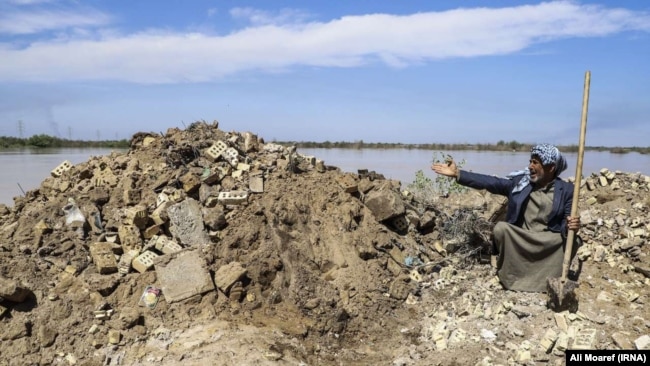Radiofarda – Flood emergencies continue in Western Iran, with tens of thousands of people sheltering in the open with little food or warm cloths to endure the cold and wet weather.
The number of people who have dies as because of floods has reached 62, with hundreds injured.
Flood waters have devastated most of Lorestan and have inundated the southwestern oil-producing Khuzestan provinces.
Mohsen Rezaee, a senior conservative politician and former IRGC commander warned that Karkheh Dam in Khuzestan is facing a critical situation. Quoting the management of the dam, Rezaee said that if more water is not released in coming days, with the next rains expected soon, the whole dam can be in danger and “a big tragedy can happen.”
A member of Iranian parliament reported from Pol-e-Dokhtar, the worst hit town, that many people “have spent two nights in the open, having fled to the mountains and have nothing”, Fars news agency quoted Hamidreza Kazemi as saying. The lawmaker appealed to government and organizations to send food and warm cloths to the area.

Kazemi reported that 60 villages in Lorestan are under flood water and cut-off from the outside world. Also, half of Pol-e-Dokhtar and Mamoolan and twenty adjacent villages are also under water.
An outspoken member of parliament, Mahmoud Sadeghi warned President Hassan Rouhani that Lorestan province “is facing a tragedy”. Sadeghi tweeted that “Pol-e Dokhtar is buried in mud, people’s needs such as food, drinking water and medicine have not been addressed and the lack of order and planning are widespread”.
The representative of Lorestan’s governor in Mamoolan told Mehr news agency that all roads to the town are cut and until Wednesday morning there was connection to the outside world. He also criticized the Iranian Red Crescent for not being present in the region, insisting that if rescue workers had been sent in time, “our problems would have been addressed”.
In response to criticism on the state-controlled television, a government official lashed out at the management of a channel saying their programs are “killing hope” among people when the country is already suffering under sanctions.
Governor of Kermanshah province in the west said that floods have brought huge damage to roads and canals. He told IRNA on April 2 that road damage alone has reached $60 million.

IRNA reports that 70,000 hectares of agricultural land in Kermanshah has been damaged and it is early to estimate the monetary value of the disaster.
Another official had told the media on April 1 that floods have brought $1 billion in losses to the agricultural sector in 12 provinces. This estimate is bound to increase with floods that have wreaked havoc since April 1.
The chief commander of the Islamic Revolution Guard Corps on April 3 told Iranians to be patient, adding “This blessing from God has been sent to Iran and we must appreciate it”. In recent days, other Islamic Republic officials, such as president Rouhani have expressed similar sentiments.
Iran was suffering from drought for several years before =the unexpected rainstorms, which began in mid-March. EMBED SHARE
 Shabtabnews In this dark night, I have lost my way – Arise from a corner, oh you the star of guidance.
Shabtabnews In this dark night, I have lost my way – Arise from a corner, oh you the star of guidance.


